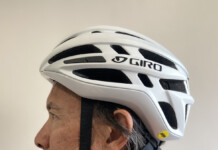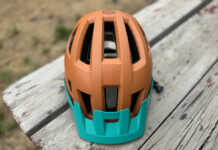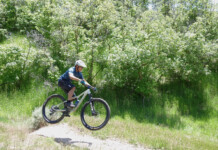
By Tom Jow
Last week I was in Fruita, CO and Moab mountain biking with some friends from out of state. The weather was great and the trail conditions were excellent. One of my companions did find one thing to complain about though, his disc brakes. Apparently they are always making some sort of noise. When the brakes are disengaged they go “ching, ching, ching,” and when they are engaged, they often make a high pitched squealing sound. These would be the two most common complaints that riders have about disc brakes. Fortunately, these issues can be easily, and relatively inexpensively remedied.
In the case of the brake that makes a rhythmic tinging sound, there are two reasons this occurs. The first is a rotor that is not perfectly true. Unfortunately, few of them are. It is possible sometimes, that rotating the rotor to a different position on the hub will result in a smaller wobble. The second reason is a brake caliper that is slightly misaligned. An additional factor is that one or both of the brake pistons may be sticky. The first step in addressing this is to completely reset the brake pads and pistons.
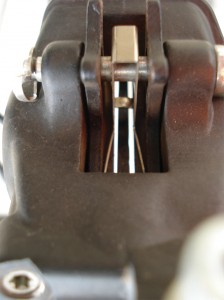
Begin by removing the wheel of the brake in question. Next, insert the Park PP-1 brake piston tool (a screwdriver is not a good substitute). This will do several things. One, it resets the brake pistons equally and squarely. Two, by pressing the pistons back into the bores it lubricates them. Three, it makes you aware of how much brake pad material is left before replacement is necessary.
Next, reinstall the wheel. If done properly, there should be a lot of room between the brake pads and the disc rotor.
At this point, squeeze the brake lever several times. The first couple squeezes will come to the grip as brake fluid is re-transferred back to the caliper from the master cylinder. Keep squeezing until the lever is firm. Spin the wheel. If all has gone well, the pads will be re-aligned and the brake will roll silent. If not, then the brake caliper will need some manual adjustment.
Using a 5mm hex wrench (or whatever the proper size for your brakes), loosen one caliper mounting bolt ever so slowly
until it barely moves under pressure. Then loosen the second one the same amount. Now, looking down into the caliper body/ brake pad inspection window, adjust the caliper until the rotor passes with no sound. Before re-tightening the bolts, gently squeeze and hold the brake lever tight. A strap or friend is helpful for this. This will hold the caliper in place while you completely loosen the bolts, to allow the caliper to free center itself, and then tighten them down for good. This part of the procedure is also easily performed on the trail.
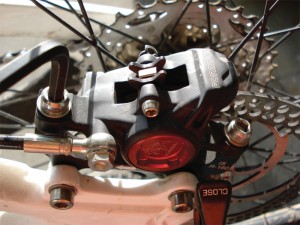
The high pitched squealing brakes can be a little more difficult to diagnose. The main cause of disc brake squealing is vibration. One of the most significant factors is brake pad choice. The are two types, metallic and organic. Metallic pads are composed of just what the name implies, metal. This type of pad has good pad bite, resists heat and wears well in both dry and wet conditions. Because of the metal in the pads, they can sound a little scratchy. Metallic pads work best for riders who want to brake hard, brake late, and/or ride in a variety of conditions. Organic pads on the other hand, have no metal in the braking material. For this reason they are quieter, bite smoother and vibrate less. Organic pads work well for riders use the brakes for more sustained periods of time.
Another factor is overheated rotors and pads. Overheating often occurs when brakes are new and not broken in (bed in) properly. Overheated rotors and pads develop a glaze on the braking surface which greatly diminishes braking power. This glaze may also cause the pads and rotor to vibrate during use. Evidence of overheating is indicated by a bluish tint on the brake rotors.
Dirt and other contaminants in the braking system also contribute to brake noise and poor braking performance. Brake rotors can be cleaned with isopropyl alcohol and a clean paper towel. Brake pads are very absorbent so if they become contaminated, it’s best to just replace them.
In order to really have quiet brakes, it may be necessary to start from scratch by replacing the rotors and pads. Always purchase new pads with new rotors. Purchase the proper pads for your riding style. Bed them in properly ( see manufacturers manual for instructions). Perform brake maintenance by resetting the pads with the PP-1 regularly and replacing worn brake pads at proper intervals. Take good care of your brakes and you will be wanting to ride ahead of your friends to avoid listening to their brakes, and their complaints.
Got a bike question? Email Tom at 1tomjow@gmail.com.

